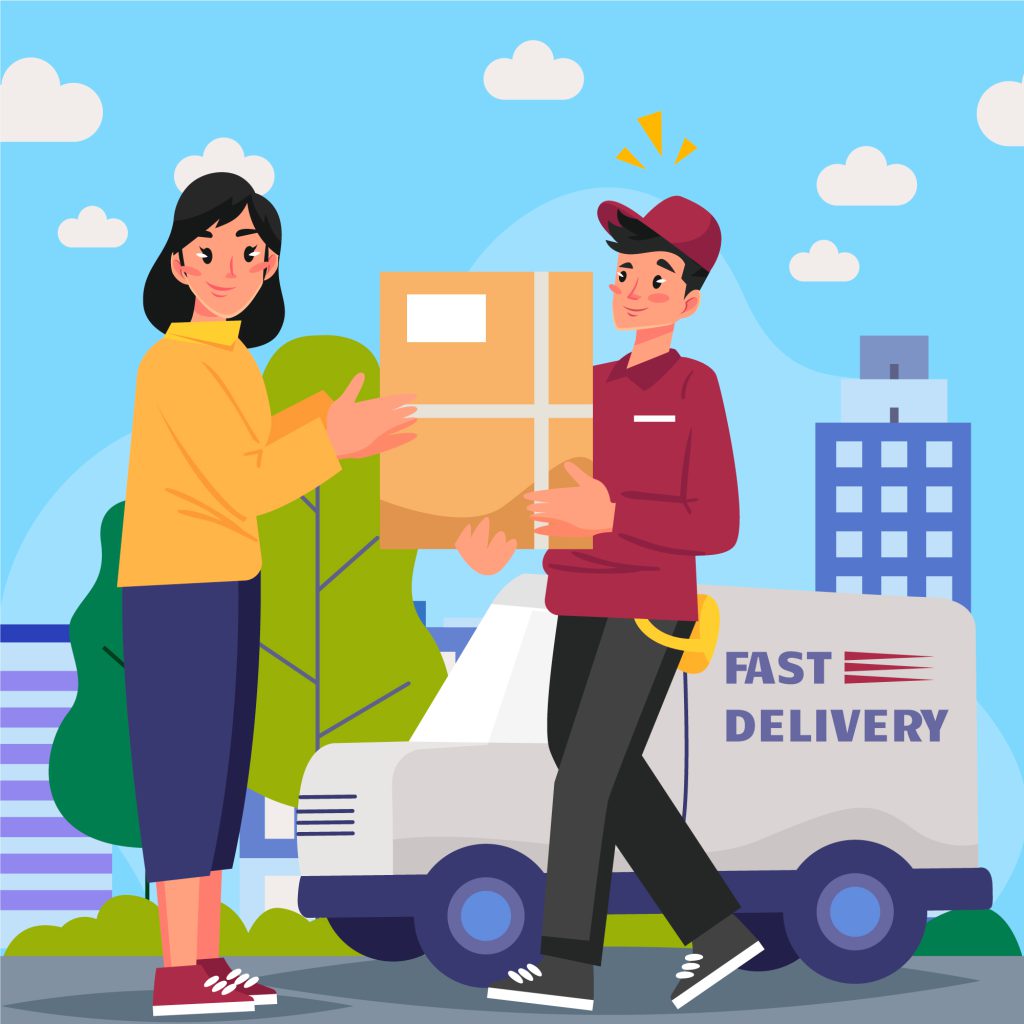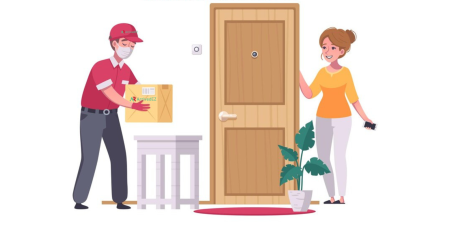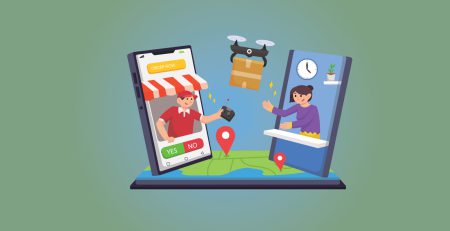The Evolution of Same-Day Delivery Services: A Comprehensive Timeline
Arrived EZ2024-01-14T16:12:01+00:00In the fast-paced world of e-commerce, the demand for swift and efficient delivery services has driven the evolution of logistics to new heights. One of the most significant advancements in recent years has been the rise of same-day delivery services. This blog explores the comprehensive timeline of the evolution of same-day delivery, from its humble beginnings to the innovative solutions shaping the industry today.
- Early Days: The Birth of Same-Day Delivery
The concept of same-day delivery has a rich history that can be traced back to the late 19th century. During this time, local businesses and couriers played a crucial role in facilitating rapid deliveries within the confines of city limits. The late 1800s marked a period of industrialization and urbanization, with cities growing in size and commercial activities expanding.
Local businesses recognized the need for swift and efficient delivery services to meet the demands of an increasingly fast-paced urban lifestyle. Couriers and delivery services emerged to bridge the gap between suppliers and consumers, ensuring that goods could be transported quickly within the city.
One notable aspect of this era was the use of bicycle messengers in the early 20th century. These messengers became symbolic of dedication to timely service and played a vital role in the evolution of same-day delivery. Bicycles provided a nimble and quick mode of transportation, allowing messengers to navigate through congested city streets and deliver packages promptly.
The reliance on bicycle messengers set the stage for the development of more sophisticated and organized delivery systems. As urban centres continued to grow and transportation technologies advanced, the concept of same-day delivery evolved further. Over time, various modes of transportation, such as motorcycles and small vehicles, were employed to enhance the efficiency of same-day delivery services.
The early days of same-day delivery, rooted in the late 19th and early 20th centuries, laid the foundation for the logistical infrastructure and customer expectations that continue to shape modern delivery services. The commitment to timely and convenient deliveries, as demonstrated by bicycle messengers and local couriers, remains a defining characteristic of the same-day delivery industry.
2.Rise of Brick-and-Mortar Giants
The point “Rise of Brick-and-Mortar Giants” refers to the emergence of large, traditional retail companies, often characterized by physical store locations, during the mid-20th century. This era saw the rise of retail giants such as Sears and Montgomery Ward, which played a significant role in shaping the retail landscape of the time.
During this period, these brick-and-mortar giants began to explore innovative ways to gain a competitive edge in the market. One such strategy was the introduction of same-day delivery services. Same-day delivery was a revolutionary concept that provided customers with the convenience of receiving their ordered goods on the very day they placed an order. This approach aimed to enhance customer satisfaction and differentiate these retailers from their competitors.
The idea behind same-day delivery was to offer a swift and efficient fulfillment process, allowing customers to enjoy a faster turnaround time for their online or catalog orders. This approach addressed the traditional challenge of delayed delivery times associated with mail-order shopping. By providing same-day delivery, these retail giants aimed to meet customer expectations for speed and convenience, thus attracting and retaining a loyal customer base.
Sears and Montgomery Ward were pioneers in implementing same-day delivery services, and their efforts marked a crucial phase in the evolution of retail practices. While the specifics of how these services were executed might have varied, the underlying goal was to leverage logistics and distribution capabilities to fulfill customer orders rapidly.
The rise of same-day delivery as a competitive advantage by these brick-and-mortar giants reflected a strategic adaptation to changing consumer expectations. It also set a precedent for future developments in the retail industry, influencing the way businesses approached order fulfillment and customer service. As the retail landscape continued to evolve, the concept of same-day delivery would undergo further transformations with the advent of e-commerce and technological advancements in logistics and transportation.
- The Dot-Com Boom: E-Commerce Takes Center Stage
The Dot-Com Boom refers to a period in the late 1990s when there was a rapid and widespread growth of internet-based businesses, commonly referred to as “dot-coms.” During this time, there was a surge in investment in technology-related companies, leading to a speculative bubble in the stock market.
One of the key aspects of the Dot-Com Boom was the emergence of e-commerce as a dominant force in the business world. E-commerce, or electronic commerce, involves the buying and selling of goods and services over the internet. Companies like Amazon played a pivotal role in this transformation by not only establishing themselves as online marketplaces but also by introducing innovative features such as same-day delivery.
The introduction of same-day delivery was a game-changer in the world of online retail. Traditionally, consumers had to wait for several days or even weeks to receive their online orders. However, with same-day delivery options, customers could now get their products delivered to their doorstep on the same day they made the purchase. This level of speed and convenience was unprecedented and greatly influenced consumer behaviour.
The shift towards prioritizing speed and convenience marked a paradigm shift in the way people approached online shopping. Consumers became more demanding in terms of the immediacy of their purchases, and businesses had to adapt to meet these changing expectations. This shift had a profound impact on the entire retail industry, forcing brick-and-mortar stores to reconsider their strategies and invest in their online presence to stay competitive.
In summary, the Dot-Com Boom brought about a revolutionary change in the business landscape, with e-commerce taking centre stage. The introduction of same-day delivery by companies like Amazon exemplified the growing emphasis on speed and convenience in online shopping, leading to a paradigm shift in consumer behaviour and expectations.
- Technological Innovations: Tracking and Optimization
The point you’re referring to highlights the significant role that technological innovations, specifically GPS tracking systems and route optimization software, have played in the evolution of same-day delivery services. Let’s break down this statement:

GPS Tracking Systems:
Implementation: Same-day delivery services have benefited greatly from the widespread adoption of GPS (Global Positioning System) tracking systems. These systems are integrated into the delivery vehicles, allowing precise and real-time tracking of their locations.
Enhanced Efficiency:
With GPS tracking, delivery companies can monitor the exact location of their vehicles at any given time. This information is crucial for optimizing routes, providing accurate delivery time estimates, and improving overall operational efficiency.
Route Optimization Software:
Implementation:
Route optimization software is another technological innovation that has transformed the logistics and delivery industry. This software analyzes various factors, such as traffic patterns, delivery locations, and time constraints, to determine the most efficient delivery routes.
Efficiency Improvement: By optimizing delivery routes, companies can reduce travel time, fuel consumption, and operational costs. This not only speeds up the delivery process but also contributes to a more environmentally friendly and cost-effective operation.
Real-Time Tracking as a Standard Feature:
Customer Transparency:
The integration of real-time tracking as a standard feature means that customers can monitor the progress of their deliveries in real-time. This level of transparency provides customers with accurate and up-to-date information about the location and estimated time of arrival of their packages.
Customer Control:
Real-time tracking empowers customers with a sense of control over their deliveries. They can plan their day more effectively, be aware of when to expect the delivery, and even make last-minute adjustments if necessary.
Transparency and Control for Customers:
Customer Experience:
The combination of GPS tracking and route optimization contributes to an improved overall customer experience. Customers appreciate the transparency and reliability that these technologies provide, leading to increased satisfaction with the delivery service.
Competitive Advantage:
Offering real-time tracking and optimized delivery routes has become a standard expectation in the industry. Companies that excel in these technological aspects gain a competitive edge by meeting and exceeding customer expectations.
In summary, technological innovations such as GPS tracking systems and route optimization software have become integral to the same-day delivery landscape. These innovations contribute to improved efficiency, cost-effectiveness, customer satisfaction, and provide a competitive advantage in the rapidly evolving logistics industry.
- Gig Economy and Crowdsourced Delivery
The gig economy refers to a labour market characterized by short-term and flexible freelance or independent work arrangements, often facilitated through digital platforms or apps. In the context of the delivery industry, the gig economy has played a significant role in transforming traditional models by introducing on-demand services and leveraging a large pool of independent contractors or gig workers.
Companies like Uber and Lyft, initially known for their ride-sharing services, expanded their business models to include on-demand delivery services. This evolution allowed them to tap into their existing network of drivers to fulfil not only transportation needs but also the delivery of goods. This transition marked a significant shift in the way goods are transported and delivered, especially in the context of same-day delivery.
Here are key points to elaborate on the impact of the gig economy and crowdsourced delivery in the context of same-day delivery:
Flexibility and Scalability
The gig economy model provides businesses with the flexibility to scale their delivery services based on demand. Companies can quickly adapt to fluctuating order volumes without the constraints of maintaining a fixed fleet of delivery vehicles and personnel.
On-Demand Delivery:
On-demand delivery services became possible through the gig economy, enabling businesses to offer same-day or even within-the-hour delivery options. This aligns with the growing consumer preference for faster and more convenient delivery solutions.
Cost-Efficiency:
Leveraging independent contractors for delivery services can be cost-effective for businesses. Instead of bearing the fixed costs associated with employing full-time delivery staff and maintaining a fleet, companies can pay gig workers on a per-task basis, aligning costs with actual demand.
Wider Reach:
The gig economy allows businesses to extend their delivery reach without the need to establish physical locations in every potential market. Independent drivers operating in different areas can fulfill orders, making it possible for businesses to serve a broader customer base.
Technological Integration:
The success of gig economy-based delivery services is closely tied to the integration of technology. Mobile apps and online platforms enable seamless coordination between businesses, drivers, and customers, ensuring real-time tracking, communication, and efficient order management.
Challenges and Controversies:
While the gig economy has brought innovation to the delivery sector, it has also faced criticism for issues related to worker rights, job security, and fair compensation. Controversies surrounding the classification of gig workers as independent contractors versus employees have led to legal and regulatory challenges.
In summary, the gig economy and crowdsourced delivery have revolutionized the same-day delivery landscape by introducing flexible, scalable, and on-demand solutions. This model has proven effective for meeting the evolving expectations of consumers and the dynamic needs of businesses in the fast-paced world of e-commerce and logistics.
6.Amazon Prime and the Race for Instant Gratification
The point you’ve mentioned highlights the significant impact of Amazon Prime on the e-commerce industry and the subsequent race among retailers to meet the growing consumer demand for instant gratification.
Introduction of Amazon Prime (2005):
Amazon Prime was introduced in 2005 as a subscription-based service offering various benefits to members, with the key feature being free two-day shipping on eligible items.
This move was groundbreaking as it provided consumers with a new level of convenience and speed in receiving their online purchases.
Revolutionizing E-commerce:
Amazon Prime revolutionized the e-commerce landscape by redefining customer expectations regarding shipping times.
The two-day shipping guarantee not only provided a competitive advantage to Amazon but also raised the bar for other e-commerce players.
Industry-Wide Pursuit of Faster Delivery:
The success of Amazon Prime prompted other e-commerce companies to reassess their own shipping strategies.
Competitors recognized the need to offer faster delivery options to stay competitive and retain customers who were increasingly valuing quick turnaround times.
Amazon’s Same-Day Delivery Foray:
To further push the envelope, Amazon expanded its delivery options with the introduction of same-day delivery services in certain areas.
This move was a game-changer, as it brought the concept of nearly instant gratification to online shopping, reinforcing the idea that customers could get what they wanted almost immediately.
Heightened Consumer Expectations:
Amazon’s innovations in shipping not only shaped industry standards but also heightened consumer expectations for fast and reliable delivery.
Consumers began to view expedited shipping as a standard rather than a premium service, influencing their choice of where to shop online.
Impact on Retail Strategy:
The race for instant gratification prompted retailers to invest heavily in logistics, warehousing, and transportation infrastructure to shorten delivery times.
Many companies adopted strategies such as building distribution centers strategically located to major population centres to facilitate quicker deliveries.
Subscription Models and Loyalty Programs:
Amazon Prime’s success also inspired the adoption of subscription-based models and loyalty programs by other retailers, as they sought to build a loyal customer base by offering perks like expedited shipping.
Amazon Prime’s introduction of free two-day shipping in 2005 not only transformed the way people shopped online but also triggered a broader industry-wide competition to meet the demand for faster and more convenient delivery options. This shift has had a lasting impact on consumer expectations and has shaped the strategies of e-commerce businesses in the pursuit of providing instant gratification to customers.
7.Retailers Embrace Same-Day Delivery
- The point “Retailers Embrace Same-Day Delivery” highlights a trend in the retail industry where traditional brick-and-mortar retailers are adapting to the changing preferences of consumers, particularly in response to the rise of e-commerce giants. Here’s a more detailed explanation:
Changing consumer expectations:
With the growth of e-commerce, consumers have become accustomed to the convenience of online shopping, where products can be ordered and delivered to their doorstep quickly. This has led to a shift in consumer expectations, with an increasing demand for faster and more convenient delivery options.
Competition with E-commerce Giants:
E-commerce giants, such as Amazon, have set a high standard for fast and efficient delivery services. To stay competitive and retain customers, traditional retailers recognized the need to provide similar levels of convenience and speed in their delivery services.
Investment in Same-Day Delivery Infrastructure:
To meet the demand for quicker delivery, traditional retailers like Walmart and Target decided to invest in their own same-day delivery infrastructure. This involves creating and optimizing systems that allow for the swift processing and dispatching of orders, reducing the time it takes for products to reach customers.
Development of In-House Delivery Services:
Some retailers chose to develop their own in-house delivery services, allowing them to have more control over the entire delivery process. This may involve building a fleet of delivery vehicles, hiring drivers, and implementing advanced logistics technologies to streamline operations.
Partnerships with Logistics Providers:
Alternatively, some retailers formed partnerships with established logistics providers to leverage their expertise and existing infrastructure. This allows traditional retailers to quickly implement and offer same-day delivery without having to build their own extensive delivery network from scratch.
Meeting customer expectations:
By embracing same-day delivery, retailers aim to meet the evolving expectations of modern consumers, who prioritize convenience and speed. This strategy not only helps in retaining existing customers but also in attracting new ones who may be swayed by the immediacy of the delivery service.
Enhancing the in-store experience:
In addition to online orders, some retailers extended the concept of same-day delivery to in-store purchases. This could involve providing customers with the option to have their in-store purchases delivered to their homes on the same day, further enhancing the overall shopping experience.
The embrace of same-day delivery by traditional retailers is a strategic response to the changing landscape of retail, driven by the rapid growth of e-commerce and shifting consumer expectations. By investing in and offering same-day delivery services, these retailers aim to stay competitive in an increasingly dynamic and fast-paced market.
8.Autonomous Vehicles and Drones: Future Frontiers
Autonomous vehicles and drones are emerging as key technologies that have the potential to revolutionize the logistics and delivery industry, particularly in the context of same-day delivery. Let’s break down the key points related to autonomous vehicles and drones shaping the future of delivery:
Autonomous Vehicles:
Reduced Costs:
Autonomous vehicles, such as those developed by companies like Tesla and Google, have the potential to significantly reduce delivery costs. Removing the need for human drivers can lead to cost savings related to labor, insurance, and other expenses associated with human employees.
Enhanced Efficiency:
Autonomous vehicles can operate around the clock without the need for breaks, resulting in improved efficiency and faster deliveries. They can optimize routes, avoid traffic, and adapt to real-time changes in traffic conditions, leading to quicker and more reliable deliveries.
Scalability:
As the technology matures, companies can easily scale their delivery operations by deploying more autonomous vehicles. This scalability allows for handling increasing demand without a proportional increase in labor costs.
Drones:
Last-Mile Delivery:
Drones are particularly well-suited for last-mile delivery, the final leg of the delivery journey from a distribution center to the customer’s doorstep. Their ability to navigate through dense urban environments and reach remote or difficult-to-access locations makes them valuable for efficient last-mile deliveries.
Speed and Agility:
Drones can overcome traffic congestion and navigate direct routes, making them exceptionally fast for short-distance deliveries. This speed is crucial for meeting the demands of same-day delivery services and providing customers with rapid order fulfillment.
Environmental Impact:
The use of drones for delivery can contribute to reducing the environmental impact of traditional delivery methods. Drones are generally electric-powered, and their efficient routes can lead to lower carbon emissions compared to traditional delivery vehicles.
Industry Players:
Amazon: Amazon has been at the forefront of experimenting with drone technology through its Prime Air program. The company envisions using drones to deliver packages within 30 minutes of order placement, revolutionizing the speed of e-commerce deliveries.
Tesla and Google: While Tesla focuses on autonomous vehicles for various applications, including delivery, Google’s Waymo has been testing autonomous delivery vehicles. Both companies aim to leverage self-driving technology to optimize delivery logistics.
Regulatory Challenges:
Addressing Legal and Safety Concerns:
The widespread adoption of autonomous vehicles and drones for delivery faces regulatory challenges. Governments and regulatory bodies need to establish guidelines and standards to address safety, privacy, and airspace management concerns associated with these technologies.
The integration of autonomous vehicles and drones into the delivery ecosystem has the potential to transform same-day delivery by making it faster, more cost-effective, and more environmentally friendly. As technology advances and regulatory frameworks evolve, these innovations are likely to play a pivotal role in shaping the future of logistics and e-commerce.
The evolution of same-day delivery services has been a dynamic journey, driven by consumer demand, technological advancements, and industry competition. From the bicycle messengers of the 19th century to the potential of autonomous drones in the 21st century, the quest for faster and more convenient delivery options continues to shape the landscape of e-commerce. As we look ahead, it’s clear that the same-day delivery timeline will only become more intricate and fascinating, fuelled by the relentless pursuit of customer satisfaction and operational efficiency.












Leave a Reply